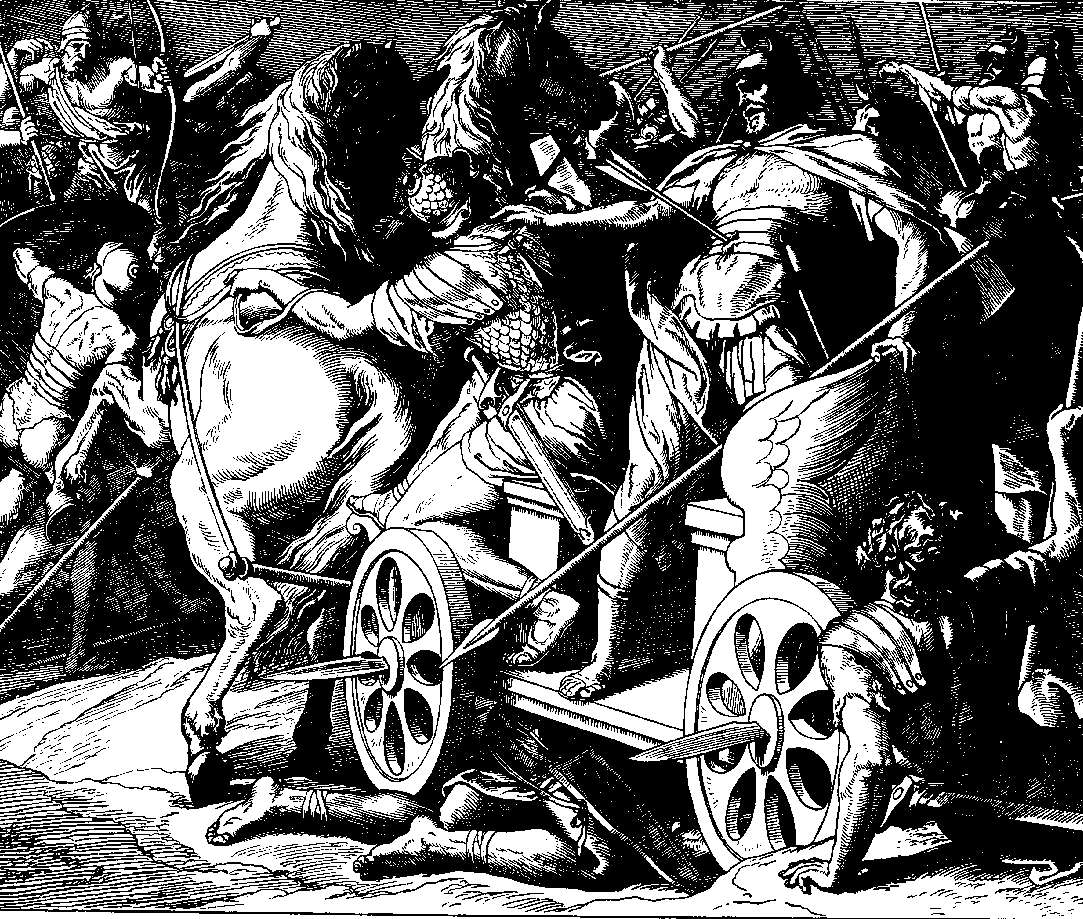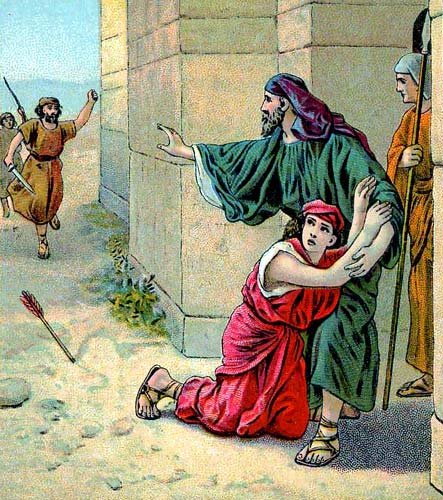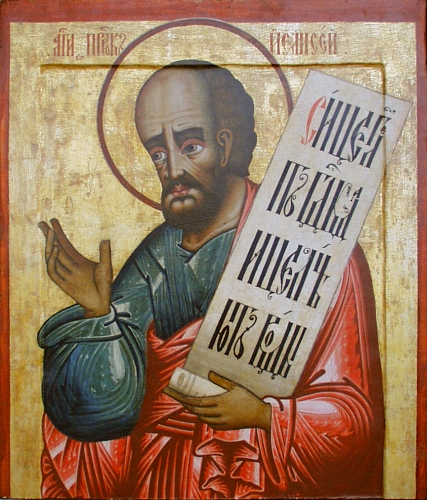|
Ramath Gilead
Ramoth-Gilead ( he, רָמֹת גִּלְעָד, meaning "Heights of Gilead"), was a Levitical city and city of refuge east of the Jordan River in the Hebrew Bible, also called "Ramoth in Gilead" (; ; ) or "Ramoth Galaad" in the Douay–Rheims Bible. It was located in the tribal territorial allotment of the tribe of Gad. Biblical events According to (), Ramothgilead was the base of Ben-Geber, one of King Solomon's regional governors. He was responsible for ("to him belonged") the towns of Jair the son of Manasseh, in Gilead and the region of Argob in Bashan: sixty large cities with walls and bronze gate-bars. It appears to have been lost to Syria (Aram-Damascus) during the battles between the northern kingdom of Israel and Syria, as Ahab, King of Israel, proposed to go to battle to win it back. After consulting prophets about the prospects of success, Ahab went to fight for Ramoth in Gilead, aided by Jehoshaphat, King of Judah. During the battle, Ahab was wounded by an arrow. ... [...More Info...] [...Related Items...] OR: [Wikipedia] [Google] [Baidu] |
Levitical City
In the Hebrew Bible, the Levitical cities were 48 cities in ancient Israel set aside for the tribe of Levi, who were not allocated their own territorial land when the Israelites entered the Promised Land. Numbers 35:1-8 relates God's command to Moses to establish 48 cities for the Levites, of which six would also function as Cities of Refuge to which manslayers could flee. Each settlement was to comprise a walled city and the common land around it for pasture, measured radially as one thousand cubits in each direction, or as a square measuring two thousand cubits along each side. The land for the cities was to be 'donated' by the host tribe and was allocated to the Levites according to their tribal sub-divisions. 13 cities were for the Aaronites. 13 cities were for the Gershonites. 10 cities were for the Kohathites. 12 cities were for the Merarites. The six cities which were to be Cities of Refuge were Golan, Ramoth, and Bezer, on the east of the Jordan River, and Kedesh, ... [...More Info...] [...Related Items...] OR: [Wikipedia] [Google] [Baidu] |
Jehoshaphat
Jehoshaphat (; alternatively spelled Jehosaphat, Josaphat, or Yehoshafat; ; el, Ἰωσαφάτ, Iosafát; la, Josaphat), according to 1 Kings 22:41, was the son of Asa, and the fourth king of the Kingdom of Judah, in succession to his father. His children included Jehoram, who succeeded him as king. His mother was Azubah. Historically, his name has sometimes been connected with the Valley of Josaphat. Reign 2 Chronicles chapters 17 to 21 are devoted to the reign of Jehoshaphat. 1 Kings 15:24 mentions him as successor to Asa, and 1 Kings 22:1-50 summarizes the events of his life. The Jerusalem Bible states that "the Chronicler sees Asa as a type of the peaceful, Jehoshaphat of the strong king". According to these passages, Jehoshaphat ascended the throne at the age of thirty-five and reigned for twenty-five years. He "walked in the ways" of his father or ancestor, King David. He spent the first years of his reign fortifying his kingdom against the Kingdom of Israel. His ... [...More Info...] [...Related Items...] OR: [Wikipedia] [Google] [Baidu] |
Ramathaim
Ramathaim-Zophim ( he, רמתיים־צופים), also called Ramah () and Ramatha in the Douay–Rheims Bible translation (Ramathaimsophim in the Vulgate), is a city from the Hebrew Bible, the home town and resting place of prophet Samuel. The name of the town means "the heights of the views." Identification Ramah, the home of Elkanah, Samuel's father (), the birthplace of Samuel and the seat of his authority (), the town is frequently mentioned in the history of that prophet and of David (). Here Samuel died and was buried (). The historian Josephus distinguishes between Ramathaim, "a city of the tribe of Ephraim," and Ramah, the burial place of Samuel the prophet. Ramathaim-Zophim has been tentatively identified with one of two sites. One of them is the modern Palestinian village of Nabi Samwil, the other the former village, now town, of er-Ram. Er-Ram as Ramah Ramah, according to Eusebius' ''Onomasticon'', was located 6 milestones north of Jerusalem (Ailia), opposite Bethel. ... [...More Info...] [...Related Items...] OR: [Wikipedia] [Google] [Baidu] |
Decapolis
The Decapolis (Greek: grc, Δεκάπολις, Dekápolis, Ten Cities, label=none) was a group of ten Hellenistic cities on the eastern frontier of the Roman Empire in the Southern Levant in the first centuries BCE and CE. They formed a group because of their language, culture, religion, location, and political status, with each functioning as an autonomous city-state dependent on Rome. They are sometimes described as a league of cities, although some scholars believe that they were never formally organized as a political unit. The Decapolis was a center of Hellenistic and Roman culture in a region which was otherwise populated by Jews, Nabataeans and Arameans. In the time of the Emperor Trajan, the cities were incorporated into the provinces of Syria and Arabia Petraea; several cities were later placed in Syria Palaestina and Palaestina Secunda. Most of the Decapolis region is located in modern-day Jordan, except Hippos and Scythopolis (in Israel), Canatha and Damascus (in Syr ... [...More Info...] [...Related Items...] OR: [Wikipedia] [Google] [Baidu] |
Aramaic
The Aramaic languages, short Aramaic ( syc, ܐܪܡܝܐ, Arāmāyā; oar, 𐤀𐤓𐤌𐤉𐤀; arc, 𐡀𐡓𐡌𐡉𐡀; tmr, אֲרָמִית), are a language family containing many varieties (languages and dialects) that originated in the ancient region of Syria. For over three thousand years, It is a sub-group of the Semitic languages. Aramaic varieties served as a language of public life and administration of ancient kingdoms and empires and also as a language of divine worship and religious study. Several modern varieties, namely the Neo-Aramaic languages, are still spoken in the present-day. The Aramaic languages belong to the Northwest group of the Semitic language family, which also includes the Canaanite languages such as Hebrew, Edomite, Moabite, and Phoenician, as well as Amorite and Ugaritic. Aramaic languages are written in the Aramaic alphabet, a descendant of the Phoenician alphabet, and the most prominent alphabet variant is the Syriac alphabet. The ... [...More Info...] [...Related Items...] OR: [Wikipedia] [Google] [Baidu] |
Koine Greek
Koine Greek (; Koine el, ἡ κοινὴ διάλεκτος, hē koinè diálektos, the common dialect; ), also known as Hellenistic Greek, common Attic, the Alexandrian dialect, Biblical Greek or New Testament Greek, was the common supra-regional form of Greek spoken and written during the Hellenistic period, the Roman Empire and the early Byzantine Empire. It evolved from the spread of Greek following the conquests of Alexander the Great in the fourth century BC, and served as the lingua franca of much of the Mediterranean region and the Middle East during the following centuries. It was based mainly on Attic and related Ionic speech forms, with various admixtures brought about through dialect levelling with other varieties. Koine Greek included styles ranging from conservative literary forms to the spoken vernaculars of the time. As the dominant language of the Byzantine Empire, it developed further into Medieval Greek, which then turned into Modern Greek. Literary Koine ... [...More Info...] [...Related Items...] OR: [Wikipedia] [Google] [Baidu] |
New Testament
The New Testament grc, Ἡ Καινὴ Διαθήκη, transl. ; la, Novum Testamentum. (NT) is the second division of the Christian biblical canon. It discusses the teachings and person of Jesus, as well as events in first-century Christianity. The New Testament's background, the first division of the Christian Bible, is called the Old Testament, which is based primarily upon the Hebrew Bible; together they are regarded as sacred scripture by Christians. The New Testament is a collection of Christian texts originally written in the Koine Greek language, at different times by various authors. While the Old Testament canon varies somewhat between different Christian denominations, the 27-book canon of the New Testament has been almost universally recognized within Christianity since at least Late Antiquity. Thus, in almost all Christian traditions today, the New Testament consists of 27 books: * 4 canonical gospels (Matthew, Mark, Luke, and John) * The Acts of the Apostl ... [...More Info...] [...Related Items...] OR: [Wikipedia] [Google] [Baidu] |
Armageddon
According to the Book of Revelation in the New Testament of the Christian Bible, Armageddon (, from grc, Ἁρμαγεδών ''Harmagedōn'', Late Latin: , from Hebrew: ''Har Məgīddō'') is the prophesied location of a gathering of armies for a battle during the end times, which is variously interpreted as either a literal or a symbolic location. The term is also used in a generic sense to refer to any end of the world scenario. In Islamic theology, Armageddon is also mentioned in Hadith as the Greatest Armageddon or Al-Malhama Al-Kubra (the great battle). The "mount" of Megiddo in northern Israel is not actually a mountain, but a tell (a mound or hill created by many generations of people living and rebuilding on the same spot) on which ancient forts were built to guard the Via Maris, an ancient trade route linking Egypt with the northern empires of Syria, Anatolia and Mesopotamia. Megiddo was the location of various ancient battles, including one in the 15th century B ... [...More Info...] [...Related Items...] OR: [Wikipedia] [Google] [Baidu] |
Hugh J
Hugh may refer to: *Hugh (given name) Noblemen and clergy French * Hugh the Great (died 956), Duke of the Franks * Hugh Magnus of France (1007–1025), co-King of France under his father, Robert II * Hugh, Duke of Alsace (died 895), modern-day France * Hugh of Austrasia (7th century), Mayor of the Palace of Austrasia * Hugh I, Count of Angoulême (1183–1249) * Hugh II, Count of Angoulême (1221–1250) * Hugh III, Count of Angoulême (13th century) * Hugh IV, Count of Angoulême (1259–1303) * Hugh, Bishop of Avranches (11th century), France * Hugh I, Count of Blois (died 1248) * Hugh II, Count of Blois (died 1307) * Hugh of Brienne (1240–1296), Count of the medieval French County of Brienne * Hugh, Duke of Burgundy (d. 952) * Hugh I, Duke of Burgundy (1057–1093) * Hugh II, Duke of Burgundy (1084–1143) * Hugh III, Duke of Burgundy (1142–1192) * Hugh IV, Duke of Burgundy (1213–1272) * Hugh V, Duke of Burgundy (1294–1315) * Hugh Capet (939–996), King of France * ... [...More Info...] [...Related Items...] OR: [Wikipedia] [Google] [Baidu] |
Jehu
) as depicted on the Black Obelisk of Shalmaneser III , succession = King of Northern Israel , reign = c. 841–814 BCE , coronation = Ramoth-Gilead, Israel , birth_date = c. 882 BCE , death_date = c. 814 BCE , burial_place = Samaria, Kingdom of Israel , predecessor = Jehoram , successor = Jehoahaz , issue = Jehoahaz , father = Jehoshaphat Jehu ( he, יֵהוּא, translit=Yēhūʾ, meaning "Yahu is He"; akk, 𒅀𒌑𒀀 ''Ya'úa'' 'ia-ú-a'' la, Iehu) was the tenth king of the northern Kingdom of Israel since Jeroboam I, noted for exterminating the house of Ahab. He was the son of Jehoshaphat, grandson of Nimshi, and possibly great-grandson of Omri, although the latter notion is not supported by the biblical text. His reign lasted for 28 years. William F. Albright has dated his reign to 842–815 BCE, while E. R. Thiele offers the dates 841–814 BCE. The principal source for the events of his reign comes from 2 Kings. Biblical ... [...More Info...] [...Related Items...] OR: [Wikipedia] [Google] [Baidu] |
Elisha
Elisha ( ; or "God is my salvation", Greek: , ''Elis îos'' or , ''Elisaié,'' Latin: ''Eliseus'') was, according to the Hebrew Bible, a prophet and a wonder-worker. His name is commonly transliterated into English as Elisha via Hebrew, Eliseus via Greek and Latin, or Alyasa via Arabic, and Elyasa or Elyesa via Turkish. Also mentioned in the New Testament and the Quran, Elisha is venerated as a prophet in Judaism, Christianity and Islam and writings of the Baháʼí Faith refer to him by name. Before he settled in Samaria, Elisha passed some time on Mount Carmel. He served from 892 until 832 BC as an advisor to the third through the eighth kings of Judah, holding the office of "prophet in Israel". He is called a patriot because of his help to soldiers and kings. In the biblical narrative, he is a disciple and protégé of Elijah, and after Elijah was taken up in a whirlwind, Elisha received a double portion of his power and he was accepted as the leader of the sons of th ... [...More Info...] [...Related Items...] OR: [Wikipedia] [Google] [Baidu] |
Hazael
Hazael (; he, חֲזָאֵל, translit=Ḥazaʾēl, or , romanized as: ; oar, 𐡇𐡆𐡀𐡋, translit= , from the triliteral Semitic root ''h-z-y'', "to see"; his full name meaning, " El/God has seen"; akk, 𒄩𒍝𒀪𒀭, Ḫa-za-’- ilu) was an Aramean king who is mentioned in the Bible. Under his reign, Aram-Damascus became an empire that ruled over large parts of Syria and Israel. While he was likely born in the greater Damascus region of today, his exact place of birth is still controversial, with both Bashan and the Beqaa Valley being favoured by different historians. In the Bible Hazael is first mentioned by name in . God tells Elijah the prophet of God to anoint Hazael king over Syria. Years after this, the Syrian king Ben-Hadad II, probably identical to Hadadezer mentioned in the Tel Dan Stele, was ill and sent his court official Hazael with gifts to Elijah's successor, Elisha. Elisha told Hazael to tell Hadadezer that he would recover, and he revealed to Haza ... [...More Info...] [...Related Items...] OR: [Wikipedia] [Google] [Baidu] |







